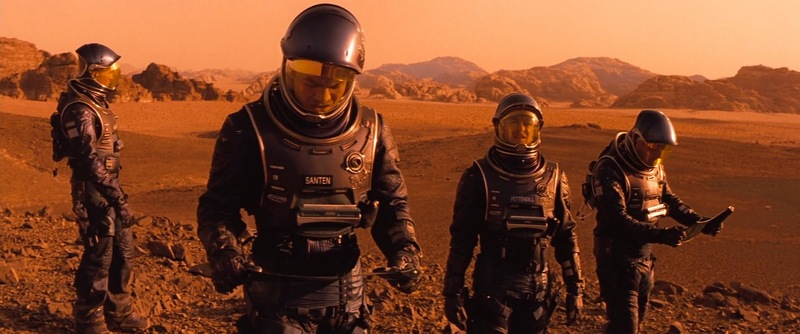
When Survival Becomes Humanity’s Last Experiment
MOVIE REVIEW
Red Planet [Limited Edition]
–
Genre: Science Fiction, Action, Thriller
Year Released: 2000, Arrow Video 4K 2025
Runtime: 1h 46m
Director(s): Antony Hoffman
Writer(s): Chuck Pfarrer, Jonathan Lemkin
Cast: Val Kilmer, Carrie-Anne Moss, Tom Sizemore, Benjamin Bratt, Simon Baker, Terence Stamp
Where to Watch: available November 18, 2025, pre-order your copy here: www.arrowvideo.com, www.mvdshop.com, or www.amazon.com
RAVING REVIEW: When RED PLANET arrived in 2000, the world was still dreaming about reaching Mars. Instead of hope, what audiences got was a film that turned that dream into a desperate, oxygen-starved survival story. It came out the same year as Brian De Palma’s MISSION TO MARS, giving us one of the oddest box office rivalries of its era: two big-budget, serious-faced Mars movies released months apart, each trying to prove who could make humanity’s last hope look more believable. Antony Hoffman’s film didn’t win that race, but it didn’t completely crash either—it simply stranded itself somewhere between philosophical drama and popcorn survival thriller.
Set in the mid-21st century, the film opens with a grim truth: Earth is dying. Pollution, population growth, and politics have pushed the planet to the brink of disaster (sounds all too familiar, unfortunately). Humanity’s answer is Mars—a planet that might be terraformed into a second home. After years of robotic missions aimed at seeding oxygen-producing algae, the first human-crewed mission is sent to evaluate the results. Their ship, Mars-1, carries a small team of astronauts led by Bowman (Carrie-Anne Moss) and Gallagher (Val Kilmer). They’re scientists, engineers, and philosophers all rolled into one, but they’re also human—fragile, flawed, and increasingly desperate as things go wrong one by one.
A solar flare damages the ship, forcing the crew to make an emergency landing on Mars. From there, RED PLANET becomes less about exploration and more about endurance. The team faces failing equipment, limited oxygen, and a planet that refuses to cooperate. What starts as a controlled mission unravels into chaos as survival instincts take precedence over scientific curiosity. When their robotic assistant AMEE malfunctions and turns hostile, the film shifts tone again, balancing between psychological tension and pure creature feature.
Kilmer plays Gallagher as a reluctant hero, caught between ego and exhaustion. He’s not the typical cinematic astronaut—there’s a blue-collar edge to his intelligence, someone who fixes problems with duct tape instead of speeches. Kilmer’s dry wit cuts through the film’s heavier moments, even when the dialogue doesn’t always match his commitment. Carrie-Anne Moss, fresh off THE MATRIX, brings dignity and precision to Commander Bowman. Stuck in orbit after the crash, she carries the film’s emotional center in the quiet scenes where isolation feels louder than any explosion.
Tom Sizemore, Benjamin Bratt, and Simon Baker fill out the crew, each embodying different shades of human reaction to crisis—fear, arrogance, and blind faith. Terence Stamp, as the ship’s philosopher, gives the film its few moments of genuine thoughtfulness, questioning the relationship between science, faith, and survival. His scenes suggest the movie’s ambition to convey something deeper about humanity’s role in its own extinction, but those ideas never fully take hold. Instead, they get buried under a script that can’t decide if it’s making a cerebral think piece or an action movie about killer robots.
Where RED PLANET undeniably succeeds is in its visual design. The cinematography by Peter Suschitzky—known for THE EMPIRE STRIKES BACK—gives the Martian landscape both beauty and hostility. The terrain feels vast, ancient, and merciless. The dusty browns and deep reds make the planet seem less like a movie set and more like an organism rejecting its invaders. Arrow Video’s 4K restoration does justice to that visual scale, revealing the depth and texture that earlier home releases flattened. The lighting, particularly in the scenes inside the spacecraft, strikes a balance between sterile precision and a quiet sense of dread, evoking classic sci-fi aesthetics without fully imitating them.
The problem isn’t the look or the sound—it’s the story beneath it. RED PLANET constantly flirts with intelligence but rarely follows through. Its dialogue is full of half-formed philosophy and pseudo-scientific jargon that never feels natural. One moment, characters debate the meaning of existence; the next, they’re bickering like co-workers about who left the coffee pot on. The shifts in tone make the movie feel unstable, as if it were edited by two separate directors with different visions of what kind of sci-fi it wanted to be.
There’s a strange charm in that instability. The film’s attempts at seriousness give it an almost retro sincerity. It feels like a lost B-movie from the 1950s, wrapped in the polish of an early-2000s blockbuster. That quality has made it something of a cult curiosity over time—a flawed but earnest piece of space fiction that tried to make Mars frightening without resorting to aliens or cosmic horrors. Arrow Video’s new limited edition adds unexpected depth to this rediscovery. The restoration features interviews with visual effects supervisor Jeffrey A. Okun and suit designer Steve Johnson, both of whom detail the film’s ambitious production design and the technical challenges that accompanied it. Their insights underscore how RED PLANET, despite its flaws, was a genuine attempt to create a believable vision of near-future space travel. The bonus features, including the feature-length retrospective “Angry Red Planet,” position the movie as a transitional piece between the grounded realism of 1990s sci-fi and the more stylized spectacles that followed.
It’s an imperfect but intriguing relic from an era when studios still gambled on big, serious sci-fi without the safety net of established franchises. The film’s reach exceeds its grasp, but at least it reaches for something—an earnest attempt to remind us that the future doesn’t just belong to explorers, but to survivors. It may not be a great film, but it’s an oddly comforting one: proof that even on a dying world, humanity still fights to find meaning in the dust.
Please visit https://linktr.ee/overlyhonestr for more reviews.
You can follow me on Letterboxd, Instagram, Twitter, and YouTube. My social media accounts can also be found on most platforms by searching for 'Overly Honest Reviews'.
I’m always happy to hear from my readers; please don't hesitate to say hello or send me any questions about movies.
[photo courtesy of ARROW VIDEO, MVD ENTERTAINMENT]
DISCLAIMER:
At Overly Honest Movie Reviews, we value honesty and transparency. Occasionally, we receive complimentary items for review, including DVDs, Blu-rays, CDs, Vinyl Records, Books, and more. We assure you that these arrangements do not influence our reviews, as we are committed to providing unbiased and sincere evaluations. We aim to help you make informed entertainment choices regardless of our relationship with distributors or producers.
Amazon Affiliate Links:
Additionally, this site contains Amazon affiliate links. If you purchase through these links, we may receive a commission. This affiliate arrangement does not affect our commitment to honest reviews and helps support our site. We appreciate your trust and support in navigating these links.



Average Rating